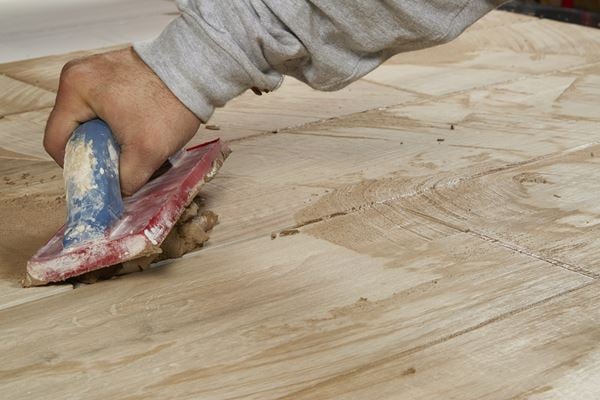Imagine this: you’re walking across your living room, enjoying the warmth of the afternoon sun streaming through the windows. Suddenly, you trip over a slight bump in the floor, a reminder of that uneven surface you’ve been meaning to fix. Frustration washes over you. You remember that friend of yours who mentioned using thinset to level their floor. But can you really do that? Is thinset the right solution for your uneven floor?

Image: home.alquilercastilloshinchables.info
Thinset, a cement-based adhesive used to secure tiles, is often touted as a quick and easy fix for uneven floors. However, the truth is a bit more nuanced. While thinset can be used to level minor imperfections, it’s not always the ideal solution for significant unevenness. This article will delve into the intricacies of using thinset for floor leveling, exploring its limitations and highlighting alternative solutions.
Understanding the Role of Thinset in Floor Leveling
Thinset’s primary function is to adhere tiles to a substrate, ensuring they remain securely in place. However, thinset’s ability to level is a secondary benefit, often employed for minor imperfections. Think of it as filling in small divots or depressions to create a smoother surface for tile installation.
Thinset’s Strengths and Limitations for Leveling
Here’s a breakdown of thinset’s capabilities and limitations when it comes to floor leveling:
- Strengths:
- Easy to use: Applying thinset is relatively straightforward, even for DIYers.
- Cost-effective: Compared to other leveling methods, thinset is an economical choice.
- Versatile: It can handle minor imperfections, including dips, bumps, and cracks.
- Limitations:
- Limited thickness: Thinset is generally applied in layers no thicker than 1/4 inch. For larger unevenness, it won’t provide enough material to level the surface effectively.
- Not suitable for all floors: Thinset is not recommended for use on certain types of flooring, such as hardwood or laminate, as it can damage the existing material.
- Risk of cracking: Thicker layers of thinset can be prone to cracking, especially in areas with heavy traffic.
When is Thinset Appropriate for Leveling?
Thinset can be a practical solution for minor floor unevenness, particularly for tile installations. Here are a few scenarios where thinset might be a suitable choice:
- Slight dips or bumps: If the floor has small imperfections that don’t significantly affect foot traffic, thinset can effectively smooth things out.
- Cracked or chipped areas: Thinset can be used to fill in small cracks or chipped sections of concrete or subfloors.
- Uneven grout lines: If you’re re-grouting existing tiles, thinset can be applied beneath to create a more even surface for the new grout.

Image: mromavolley.com
Alternatives to Thinset for Leveling
If your floor unevenness extends beyond the limitations of thinset, there are alternative solutions to consider:
1. Self-Leveling Concrete
Self-leveling concrete is a liquid mixture that flows smoothly, creating a perfectly flat surface. It’s ideal for larger unevenness and can be used to level entire rooms. However, self-leveling concrete requires proper preparation and application, making it a more complex option compared to thinset.
2. Floor Leveling Compound
Floor leveling compound is a fast-drying material specifically designed for leveling various surfaces. It comes in powder form, which is mixed with water to create a paste-like consistency. Floor leveling compounds are generally easier to apply than self-leveling concrete but still offer a good level of thickness for correcting unevenness.
3. Plywood Subfloor
Plywood subfloors are an excellent solution for significant unevenness. This method involves installing plywood sheets over the existing subfloor to create a level surface. Plywood subfloors are durable and long-lasting, providing a solid foundation for any type of flooring.
Expert Tips for Leveling Floors with Thinset
Here are some expert tips to ensure success when using thinset for minor floor leveling:
- Clean the surface: Remove any dirt, debris, or loose material from the floor before applying thinset. This ensures proper adhesion.
- Use a trowel: Apply thinset with a notched trowel to create consistent thickness and prevent air pockets.
- Allow sufficient drying time: Let the thinset dry completely before installing tiles or walking on the surface. This avoids cracking or shifting.
Can You Level A Floor With Thinset
Conclusion
While thinset can be a useful tool for leveling minor imperfections in your floor, it’s not a magic wand for all unevenness. Understanding its limitations is crucial before embarking on any floor leveling project. If you’re dealing with significant unevenness, consider alternative solutions like self-leveling concrete or floor leveling compound. Ultimately, taking the time to assess your specific situation and select the appropriate leveling method ensures a smooth, even floor for years to come.
Ready to tackle your floor leveling project? Start your journey with a trusted local contractor or DIY expert. They can provide guidance on the best approach, appropriate materials, and help you achieve the desired outcome for your floor.






